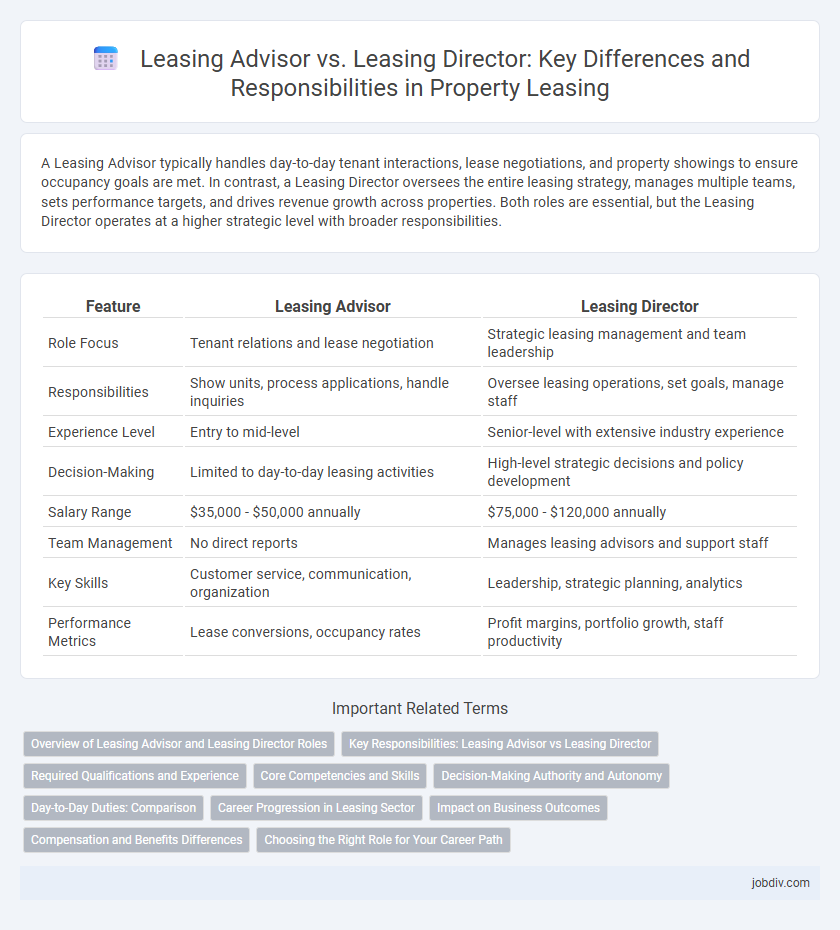A Leasing Advisor typically handles day-to-day tenant interactions, lease negotiations, and property showings to ensure occupancy goals are met. In contrast, a Leasing Director oversees the entire leasing strategy, manages multiple teams, sets performance targets, and drives revenue growth across properties. Both roles are essential, but the Leasing Director operates at a higher strategic level with broader responsibilities.
Table of Comparison
| Feature | Leasing Advisor | Leasing Director |
|---|---|---|
| Role Focus | Tenant relations and lease negotiation | Strategic leasing management and team leadership |
| Responsibilities | Show units, process applications, handle inquiries | Oversee leasing operations, set goals, manage staff |
| Experience Level | Entry to mid-level | Senior-level with extensive industry experience |
| Decision-Making | Limited to day-to-day leasing activities | High-level strategic decisions and policy development |
| Salary Range | $35,000 - $50,000 annually | $75,000 - $120,000 annually |
| Team Management | No direct reports | Manages leasing advisors and support staff |
| Key Skills | Customer service, communication, organization | Leadership, strategic planning, analytics |
| Performance Metrics | Lease conversions, occupancy rates | Profit margins, portfolio growth, staff productivity |
Overview of Leasing Advisor and Leasing Director Roles
Leasing Advisors primarily engage with prospective tenants, guiding them through property options, lease terms, and application processes to secure new leases. Leasing Directors oversee leasing teams, develop strategic leasing plans, set performance targets, and manage high-level negotiations to maximize occupancy and revenue. Both roles require strong knowledge of market trends, tenant needs, and property management principles but differ in scope, with Advisors focused on customer interaction and Directors on leadership and strategy.
Key Responsibilities: Leasing Advisor vs Leasing Director
Leasing Advisors focus on client engagement, property tours, application processing, and assisting prospective tenants with lease agreements to ensure occupancy targets are met. Leasing Directors oversee leasing strategies, manage leasing teams, develop marketing plans, and analyze market trends to optimize revenue and portfolio performance. While Leasing Advisors handle day-to-day tenant interactions, Leasing Directors drive high-level operational decisions and coordination across departments.
Required Qualifications and Experience
Leasing Advisors typically require a high school diploma or equivalent, with 1-3 years of experience in real estate or property management, strong customer service skills, and knowledge of leasing software. Leasing Directors usually need a bachelor's degree in business, real estate, or a related field, combined with over 5 years of leadership experience in leasing or property management, expertise in market analysis, and proven team management capabilities. Advanced qualifications for Leasing Directors often include certifications such as Certified Property Manager (CPM) or Real Property Administrator (RPA).
Core Competencies and Skills
Leasing Advisors excel in customer service, property marketing, and lease negotiation, leveraging strong communication and interpersonal skills to attract and retain tenants. Leasing Directors possess advanced leadership abilities, strategic planning expertise, and financial acumen to oversee leasing operations, optimize portfolio performance, and manage teams effectively. Both roles require knowledge of market trends, legal compliance, and property management software, but the director role demands higher-level decision-making and organizational management skills.
Decision-Making Authority and Autonomy
A Leasing Director holds greater decision-making authority and autonomy compared to a Leasing Advisor, overseeing strategic leasing decisions and team management. Leasing Advisors primarily execute leasing activities and provide recommendations but typically require approval from directors for final decisions. Directors set leasing policies and negotiate high-value contracts, while advisors focus on client interactions and market analysis.
Day-to-Day Duties: Comparison
Leasing Advisors manage daily tenant interactions, property showings, and lease agreement preparations, ensuring prospective tenants receive personalized assistance and accurate information. Leasing Directors oversee strategic leasing operations, coordinate team performance, and analyze market trends to optimize property occupancy and revenue growth. While Advisors focus on direct client engagement, Directors prioritize leadership, policy implementation, and long-term leasing objectives.
Career Progression in Leasing Sector
Leasing Advisors typically handle tenant relations and property tours, gaining essential experience in client communication and market knowledge. Progression to Leasing Director involves overseeing leasing strategies, managing teams, and driving portfolio growth, reflecting increased leadership and operational responsibilities. Career advancement in the leasing sector demands a strong track record in leasing metrics, negotiation skills, and team management capabilities.
Impact on Business Outcomes
Leasing Advisors directly engage with prospective tenants, driving occupancy rates and generating immediate rental income through personalized leasing strategies. Leasing Directors oversee leasing operations, optimize team performance, and develop long-term strategies that significantly enhance portfolio value and revenue growth. The combined impact of both roles elevates overall business outcomes by balancing short-term tenant acquisition with sustainable asset management.
Compensation and Benefits Differences
Leasing Advisors typically earn a base salary with commission incentives tied to lease agreements, resulting in moderate total compensation focused on transactional performance. Leasing Directors receive higher fixed salaries complemented by bonuses, profit-sharing, and enhanced benefits such as stock options, healthcare packages, and retirement plans due to their strategic and managerial responsibilities. Compensation differences reflect the shift from customer-facing leasing tasks to executive-level decision-making and team leadership within property management.
Choosing the Right Role for Your Career Path
Leasing Advisor focuses on client interaction, property tours, and lease negotiations, making it ideal for professionals seeking hands-on experience in real estate sales and customer service. Leasing Director oversees the leasing team, develops strategies, and manages operational goals, suited for those aiming for leadership roles and broader business impact within property management. Assess career goals, desired responsibilities, and leadership aspirations when choosing between these roles to align your professional growth with the right leasing position.
Leasing Advisor vs Leasing Director Infographic

 jobdiv.com
jobdiv.com